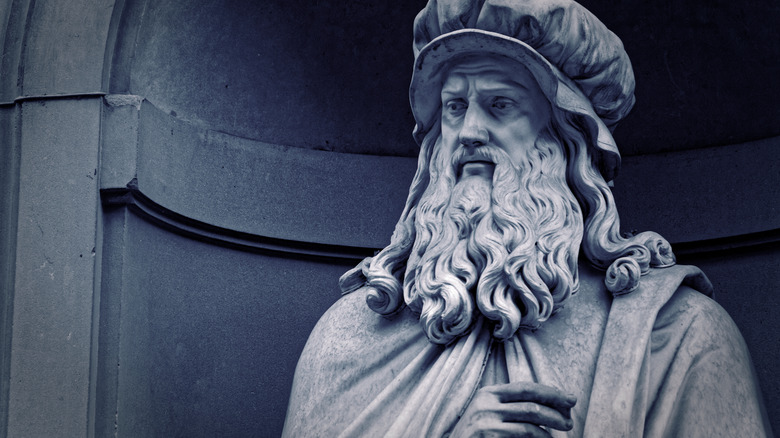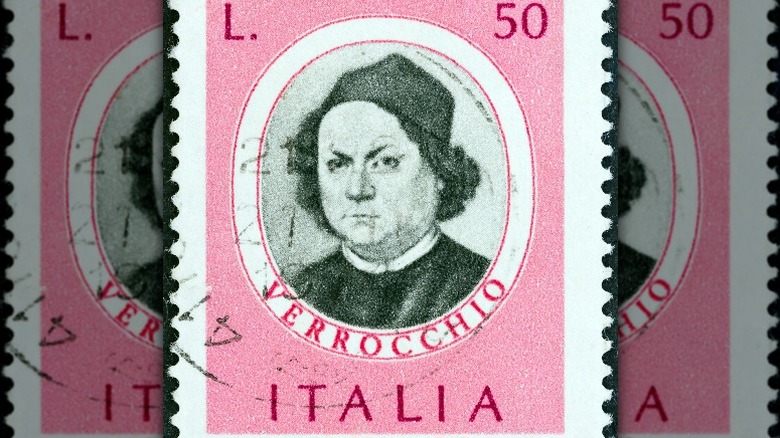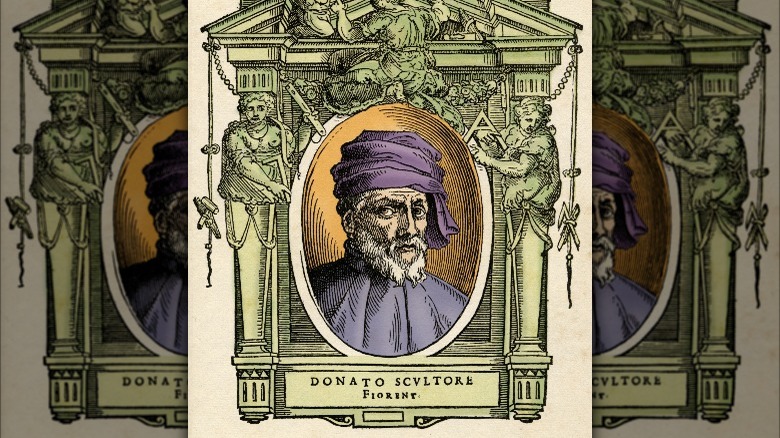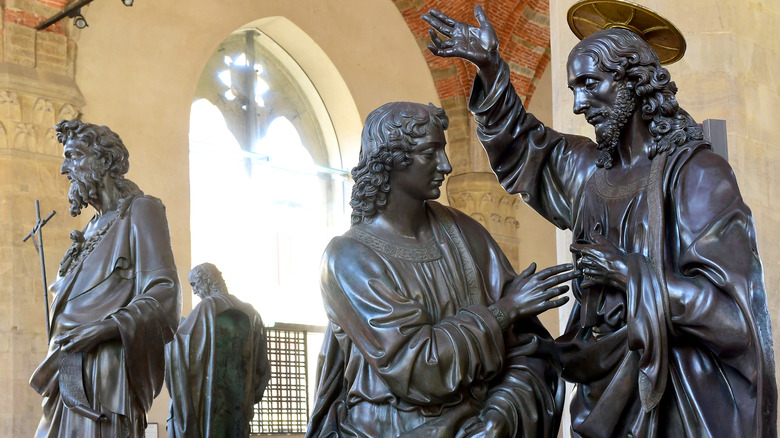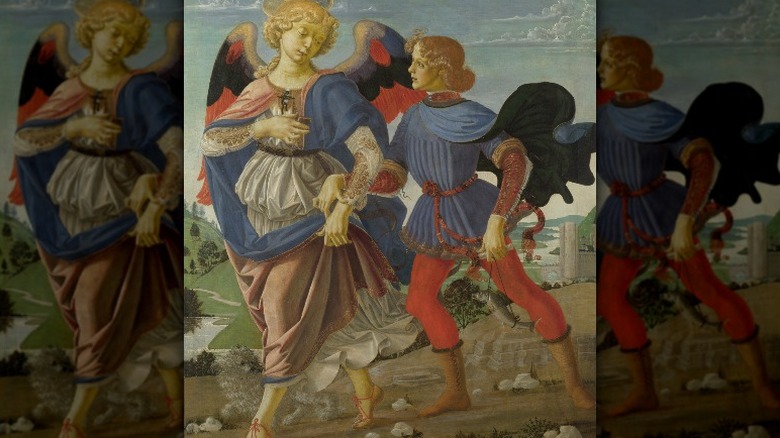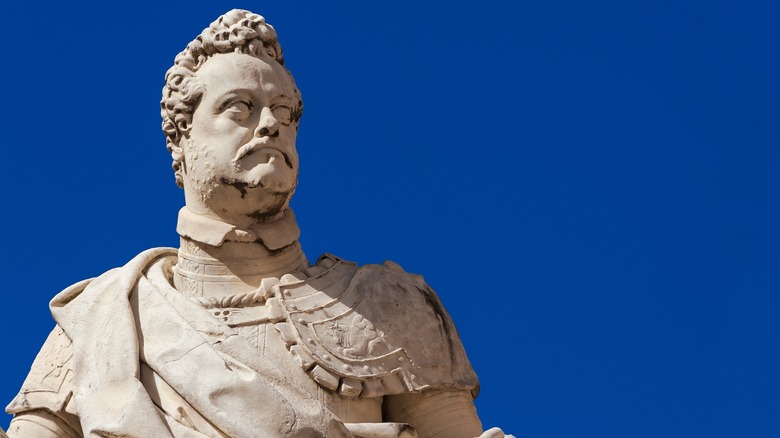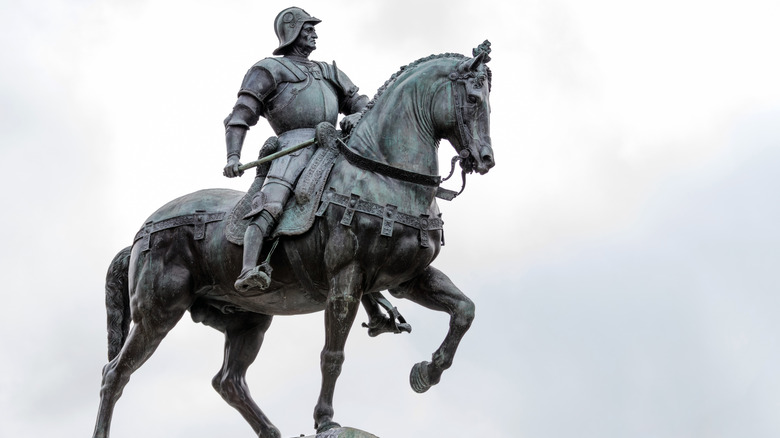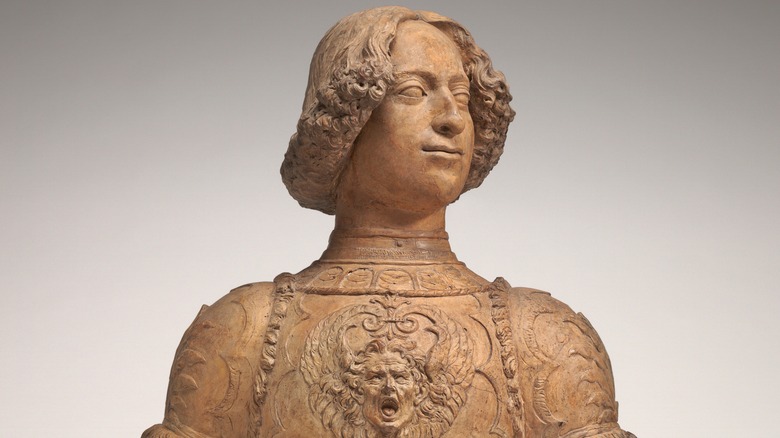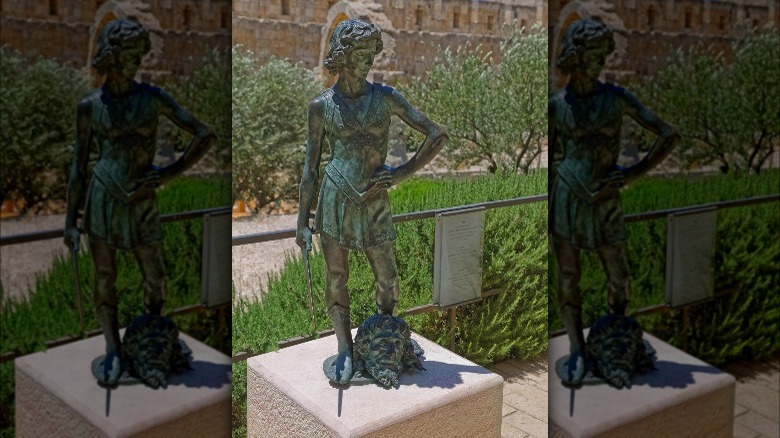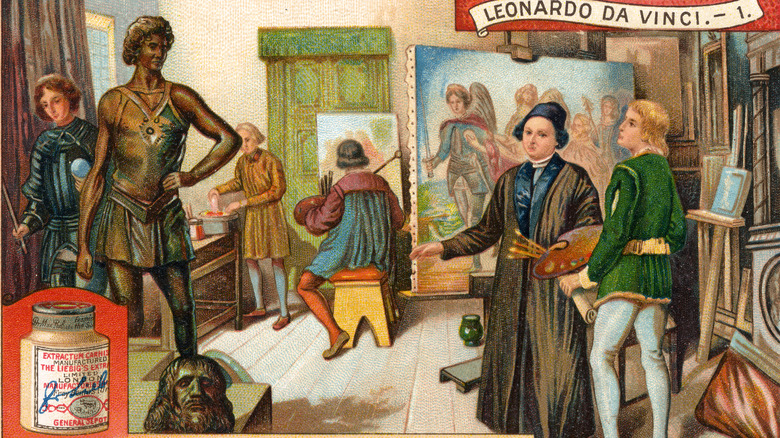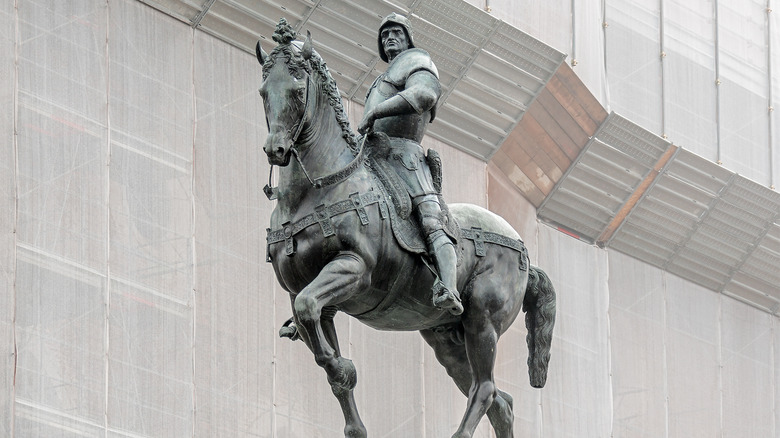Who Taught Leonardo Da Vinci?
It's hard to quantify the intelligence of someone like Leonardo da Vinci. Clever turns of phrase like "he was ahead of his time" or "he was a Renaissance man" just don't do the trick, because he was so much more than either of those things. Many would argue that da Vinci is one of the most intelligent people to have ever lived, and Insider backs that notion up, ranking him third, with an IQ likely between 180 and 220 — placing him just behind Albert Einstein, whose last name colloquially means "genius," and Johann Goethe, who may very well have known everything.
One logical follow-up question to that should be "Well who taught these people?" because you don't just become a master artist while also maintaining a genius mind. Einstein and Goethe each went into a multitude of fields that you can, for the most part, teach yourself. Mathematics, poetry, science, engineering, and the like. It's no easy feat, mind you, but it can be done.
Da Vinci had to learn to operate different mediums, from sculpture to sketches, and that rarely comes from self-exploration. It came from a man, who surely must have been at least somewhat of a genius himself if he was able to kindle the mind of Leonardo da Vinci; that man's name was Andrea del Verrocchio. Oddly enough, not much is known about this man who, aside from being da Vinci's teacher, was something of a creative force in his own right. So let's dig into who this man was who taught the fabled mind of Leonardo da Vinci.
His family situation
Every genius has an origin, and Andrea del Verrocchio, unsurprisingly, has his own; albeit, a not-so-romantic one that's rather run-of-the-mill for his time. While little is known about Verrochio outside of his artwork, there are enough surviving details to piece together his rather mundane childhood of financial insecurities. He was the son of a brick-maker turned tax collector, according to Britannica, and as such, he had a familial obligation to become an apprentice to help support his siblings.
He began his training as an apprentice goldsmith, learning to use his hands in a useful medium that could bring moderate financial returns to his struggling family situation. As he aged and grew into his artistry, he never did marry, but he did use what financial gain he mustered for himself to support his various nieces and nephews, and all of their educational aspirations, as well as the dowries of various nieces as well. All this would seem to hint that he had some financial security from his artistic gains if he was able to foot so much of the family bill.
All of this is backed up by four documents recently found in Florence pertaining to Verrocchio and his estate, summed up by Dario A. Covi (in The Art Bulletin), who writes, among many other things, that Verrocchio kept artist apprentices on salary during his time in his studio, and kept his brother Tomasso in his financial equation at all times, even in death. While many artists are known to have died destitute, Verrocchio was not one of them.
Who Verrocchio was taught by
Another way we can learn a bit more about the man who taught Leonardo da Vinci is by looking at who he himself was taught by. The problem there is that this is all a part of the muddled history behind Andrea del Verrocchio. There are plenty of ideas as far as who Verrocchio learned from, and plenty of theories to go along with. For starters, while an apprentice, he served the goldsmith Giuliano Verrocchi, who Andrea liked so much that he took his surname, according to Britannica. Little else is known about the goldsmith.
Then there is the theory that Andrea del Verrocchio had something of a prestigious master himself — Donatello, which would make Verrocchio the link connecting two ninja turtles. Unfortunately, there isn't a lot of evidence backing up any such apprenticeship to Donatello, nor to another Italian artist he was rumored to have learned from — Alessio Baldovinetti. While there is a little more evidence tying those two together, Verrocchio acquired a good deal of his sculpting knowledge beginning from his time as a goldsmith and extending into his tutelage under yet another Italian artist — Fra Filippo Lippi (whose name is very fun to say quickly).
This, according to the National Gallery of Art, creates an important link in the evolution of Renaissance painting between the great Lippi and the simply sublime da Vinci. Sandwiched in between is the oft-overlooked genius of Andrea del Verrocchio himself.
He was a product of his environment
If ever there was such thing as being born in the right place at the right time, Andrea del Verrocchio embodies that principle. Born somewhere around 1435 in Italy, his country was the centerpiece of a European-wide Renaissance that saw literary, philosophical, and artistic developments popping up practically constantly. And the gross majority of that was right smack where Verrocchio was born. According to TheCollector, not only was it a creatively viable time, but financially, the Medici family was circulating with wealth to invest in the arts. All in all, it made for a very fertile soil for Verrocchio to plant his creative soul.
Tracing the growth of the Renaissance, according to History.com, while forebears like Dante of "Inferno" fame and Giotto of Scrovegni Chapel fame set the groundwork, the truly high concentration of masters began to solidify their place on the thriving artistic landscape around the mid- to late-15th century, particularly in Florence. Which is exactly timed with Verrocchio's rise, expanding into his time as a teacher as well, and arguably having his legacy smeared because of how good he was at getting the absolute best out of his students.
Inspiration is a huge chunk of the creative puzzle, and Verrocchio would not have been starved for it, as he began working his way around goldsmithing and experimenting with his creative mind.
He produced religious work
This one should come as no great surprise, but let's get it out there anyway — while the Renaissance brought about incredible advances to philosophy and the arts, most of the art being produced had something to do with religion, namely Catholicism. Given how widespread the pope's power had become, you couldn't throw a rock without hitting at least one or two Catholics during the Renaissance, especially in Italy. While corruption was widespread, the idea of an all-powerful god was a universal language, and given how few people could read, from the moment people could paint, they painted God to help those who couldn't read understand him better, according to the MET Museum, as well as serving as a sort of worship.
All this to say, it's really not surprising that Andrea del Verrocchio was chiseling statues of David — an immensely intriguing biblical character — and painting the Virgin Mary and angels (via The National Gallery). That's what made him money to continue on in his artistic endeavors.
It also has to be mentioned that most artists operated on the funds of rich donors, such as the Medici family, and those donors commissioned what was to be made with their money. Since these rich patrons were embedded in Catholicism (the Medici's produced four popes all on their own, according to History), they would have been flaunting their religiosity by donating large sums for the creation of godly art.
Propped up by the Medicis
The Medicis made Florence what it was in the Renaissance. Whatever you want to say about the corruption in the papacy and the literally Netflix drama of a family embroiled in political and religious intrigue, without their money, it's a great big question mark how Florence and Italy as a whole would have kept up with the European Renaissance. But we don't have to worry about that, because the Medici family was an immense patron of the arts — the greatest of their days, in fact, according to ARTnews.
Using their influence and money, the Medicis forged bonds with the most renowned artists of their day (and of our day, too, seeing as how no one is exactly forgetting Michelangelo) and commissioned work that would prop up the power of the Medici family. As reported by ARTnews, they would do things like having members of the Medici family painted wearing chic fashion and looking rather dashing, having that painting sent to prospective spouses, and letting the sparks fly.
Andrea del Verrocchio benefitted greatly from the Medicis' endless pockets as well. According to Britannica, Verrocchio may well never have found the success he found without the funds of Piero de' Medici and his son Lorenzo. With their money, Verrocchio produced numerous paintings and sculptures, as well as costumes and vestments for the various Medici households around Italy.
His most well-known work is the Bartolomeo Colleoni Monument
To know any great artist, you must know their most famous work, whether they be writers, musicians, or visual artists. For Michelangelo, it's the Sistine Chapel. For Leonardo da Vinci, the Mona Lisa. For Donatello, the statue of David. For Andrea del Verrocchio, it's the Bartolomeo Colleoni equestrian statue. This massive, elaborate statue sits next to the Scuola Grande di San Marco in the Campo SS Giovanni e Paolo in Venice, according to the World Monuments Fund. Colleoni himself, the man, not the statue, was a courageous military leader for the Republic of Venice, who led numerous successful campaigns against other Italian city-states in the early- to mid-15th century.
By the time of his death, he was more than deserving of some good old-fashioned immortal commemoration, and that's where Andrea del Verrocchio came into the picture, ready to produce his best work. It also just so happens to be Verrocchio's last work, which further pads the belief that Verrocchio's genius only grew with age. It is considered by the World Monuments Fund as one of the best horse-and-rider statues of the Renaissance, and there are quite a good many to choose from.
Made of bronze and thus subjected to the decay of age, salt, and air, there has been significant conservation efforts to keep this incredible work looking just as incredible as it was always meant to be.
He was a Renaissance man in two senses
The term "Renaissance Man" is now widely known. It's someone who is well-versed in a variety of subjects and crafts and talents. You can see the etymology pretty clearly. Here you have Leonardo da Vinci, master of math, engineering, science, painting, so on and so forth. But Andrea del Verrocchio was a Renaissance Man himself, and not just because he was alive and thriving during the Renaissance.
Before all of those Renaissance masters, Verrocchio was pioneering (and subsequently mastering) goldsmithing, sculpting, painting, music, and drafting, according to Art & Object. Each of these is singularly amazing, but when lumped into one man, he stands shoulder to shoulder with everyone else that boasts the name "Renaissance Man."
Verrocchio mastered goldsmithing while apprenticing with the man whose surname he would later adopt. Sculpting came soon after and remained his greatest medium throughout his days. Painting is perhaps his most unsung quality, with numerous religious works paving the way for standards of the time. As a draftsperson, he drew plans for progress that his student da Vinci would take to another level.
A duel of three Davids
One other way to properly understand the true merit of Andrea del Verrocchio's artistic genius is to simply look at with whom his art is in conversation with. For instance, consider that Verrocchio produced a statue of David. David was, after all, a popular muse for Renaissance artists. Beyond just being a religious figure, his story is one of intrigue and deep consideration.
In a 2004 article by The Washington Post, a discussion is posed on the concept of virility and the three subjects that the article examines are three different statues of David — statues by Michelangelo, Donatello, and Verrocchio. Two masters much loved and appreciated into the modern day, and the man that time seemed to forget.
The very fact that Verrocchio's David is in the same conversation as these two masters is testament to how heightened Verrocchio's ability was, especially considering how it is viewed in a positive light against the other two Davids. Michelangelo's David is well known for his heroic manliness, but Verrocchio's emphasizes both masculine and feminine traits, which paints David in a whole new light, yet one that feels even more connected with the biblical version of him.
According to the article in the Post, the Medicis commissioned both Michelangelo's and Verrocchio's versions of David, and while the difference of result is in the eye of the beholder, the quality of the craftsmanship is one in the same.
His reputation at the time
Andrea del Verrocchio has two eras of fame to consider — past and present. In the past, his reputation would have been nothing short of sparkling. According to Britannica, Verrocchio would have been a household name, known for his work in the budding Renaissance movement.
More than his own work, his reputation can be attested to by the types of artists that sought out his Florence studio for work and learning. Aside from Leonard da Vinci, who is really the only student you need when you're a teacher, there was also Pietro di Cristoforo Vannucci, better known as Perugino. If you haven't heard of Perugino, just know that he taught Raphael, which officially accounts for all four Renaissance masters who became immortalized by turtles well-versed in the martial arts. Even without Raphael, though, Perugino is another master too often forgotten among the many masters to arise during the time.
The connections don't stop there though. Domenico Ghirlandaio, the painter known to have taught Michelangelo, also has a close connection with Verrocchio. So if you're keeping track, that's one master, da Vinci, to come directly from Verrocchio's studio; another, Raphael, to come as a sort of grandchild; and a third, Michelangelo, to at least tangentially be connected to the work and tutelage of Verrocchio.
The list goes on, but the point remains the same — clearly, Verrocchio was a man revered in his time; otherwise, his studio would not have been involved in the creation of so many creative geniuses.
His reputation now
It's actually nothing short of a travesty that Andrea del Verrocchio is not remembered as fondly now as he was in the time he was at his height. However, Art & Object sums it up simply enough: He was surpassed by his student. That's a textbook way to lose your fame and become a note in someone else's. In Verrocchio's case, that someone else is obviously Leonardo Da Vinci, one of the greatest minds to have ever lived.
Still, there are art critics and scholars out there who are rather disrespectful to the memory of Verrocchio. According to Art & Object, it was because of Giorgio Vasari, a Renaissance artist himself, that Verrocchio has since been dropped into the second tier of artistic masters. Vasari wrote unfavorably of Verrocchio's work in general. Namely, he criticized that Verrocchio did not make enough of his natural gift and that his end result was "hard and crude." Which, as anyone who looks at the Bartolomeo Colleoni monument can attest to, really isn't true.
Art historian Francesco Caglioti told Art & Object that the only person who rivaled the versatile mastery of da Vinci and Michelangelo was the man himself — Andrea del Verrocchio. Caglioti highlighted how it's a shame that Verrocchio's mastery has become little more than a footnote in the artistic revelry attached to the likes of his students. So while his own legacy is somewhat diminished, TheCollector notes the sheer monetary value of artistic works to come out of his workshop alone is astounding.
